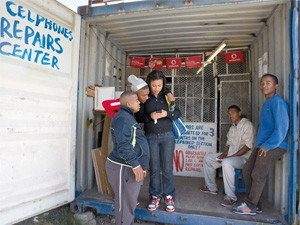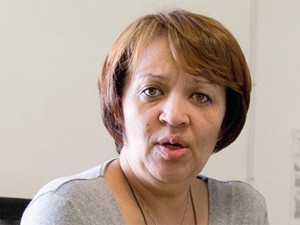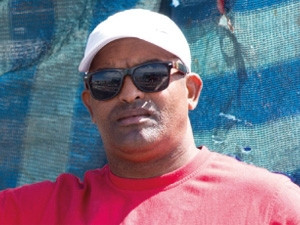
Across the world, various stakeholders are clamouring for internet connectivity to be prioritised by governments as a basic human necessity - something akin to water, electricity and sanitation. South Africa's own Communications Minister, Yunus Carrim, echoed these sentiments at a recent talk in Johannesburg.
But just how practical is the call to make the internet a fundamental human right? How would emerging market countries ever make this a reality? Carrim happened to be speaking in Sandton, a place of high-rise steel and glass, one of the heartlands of 'connected South Africa'. This is the type of area where network operators are piloting fibre to the kerb, fibre to the office, and even fibre to the home.
But there are initiatives, far removed from this, to connect citizens to the internet for free. From crowded urban townships like Mamelodi and Thembisa, to the rural farming communities of Atlantis and Robertson, public WiFi is gaining momentum as the one and only access medium that can connect poorer South Africans, en masse.
Crucial difference
One man who passionately believes in free, public WiFi is Alan Knott-Craig Jr. Previously at the helm of companies like iBurst and Mxit, Knott-Craig Jr is now leading the Isizwe Project. It's an NGO that has so far partnered with local government to deliver free WiFi services in Tshwane, Stellenbosch, and, most recently, in Atlantis and Robertson.
Knott-Craig Jr believes WiFi has three major benefits. Firstly, there's already a critical mass of WiFi-enabled devices in the hands of those that need connectivity, and the number is growing fast. "Think of all the second-hand BlackBerrys, the old laptops that get passed down. We estimate that over 50 percent of households have access to a WiFi device," he says.
The April Brainstorm cover story considered the high number of data-capable devices in the hands of South Africans, but the correspondingly low usage of mobile data - largely due to the high costs of 3G services.
The second reason to back WiFi, says Knott-Craig Jr, is that the capex involved in setting up a WiFi hub is 'an order of magnitude' cheaper than 3G infrastructure. This makes a crucial difference to the economics, and makes the provision of free bandwidth possible.

Thirdly, the opex requirements are also limited to a bare minimum. WiFi hardware is typically quite resilient and largely doesn't require specialised maintenance teams to resolve issues.
Isizwe's efforts have had significant impact. Knott-Craig Jr says that in Tshwane, its five sites have seen over 111 000 sessions, recorded by 20 000 unique users. This is all within the first few months of rolling out services, and with no marketing.
But this model relies heavily on ongoing government-support - and therein lies the rub. As the costs of providing bandwidth remain stubbornly high across the value chain, others are looking at different models to achieve the vision of self-sustaining, free WiFi zones.
Removing bottlenecks
Vox Telecom's head of Innovation, Doug Reed, says the company is piloting an advertising-subsidised model in the Gauteng settlement of Thembisa. Vox is coordinating an ecosystem of role players, bringing together local WiFi deployment partners and advertisers, and providing the bandwidth that fuels the project.
"Once we reach a certain scale, the project will start becoming truly profitable for all the parties involved," says Reed.
Is advertising-subsidised WiFi the answer? Knott-Craig Jr has his reservations, doubting that there will be enough interest from advertisers in some of South Africa's poorest and most remote communities. He describes these initiatives as 'supplementary', saying the thrust needs to come from government.
"Government policy is certainly heading in the right direction; now it's all about implementation," he advises.
Executive director at Research ICT Africa, Alison Gillwald, agrees that public WiFi has a role to play in addressing our connectivity challenges. She notes the critical importance of addressing 'upstream' issues, saying that if we can unblock some of the bottlenecks in the value chain, various last-mile WiFi options become possible.
While there may be no clear, overarching vision for public WiFi yet, she says we're not hampered by any specific regulatory or policy limitations. As a short-range frequency, WiFi itself remains unlicensed and easy to roll out.
"However, there are certainly bottlenecks at various points upstream in the provision of bandwidth that are affecting the costs, starting with issues like spectrum allocation."

This is a work in progress, she adds, noting that a number of structural market issues have been addressed in recent years. "Government has clearly acknowledged the need to bring down backhaul, backbone and access costs in order to enable an environment for public WiFi," she says.
In Minister Carrim's presentation at the recent National Conference on the ICT Policy Green Paper, he made strong promises to further accelerate the pace of market reform.
"If you do not have money, the riches of online educational content are locked behind a door for which you can't afford the key," Carrim said.
Gillwald welcomes government's promises to leverage the existing connectivity provided as a 'public good' - in places like schools, hospitals and community centres - where WiFi hotspots would be bolted-on at these locations, to serve the surrounding community.
WiFi is a very specific solution designed for a very specific need.
Steven Ambrose, StrategyWorx
"All over the world, the concept of governments offering some form of public or subsidised WiFi is increasingly regarded as good practice," she notes.
But Steven Ambrose, of local analyst firm StrategyWorx, says he's travelled to many of those free public, outdoor, WiFi zones in different cities around the world, and says the quality is often extremely poor.

He believes WiFi is a technology that's perfectly suited to enclosed environments where the number of users can be controlled, such as stadiums, shopping malls, and offices, and not necessarily most appropriate for mass usage in wider, outdoor environments. "WiFi is a very specific solution designed for a very specific need."
In contrast to this, he says Long Term Evolution (the 'evolved' state of 3G networks) will enable huge throughput of data from device to base station, and massive numbers of concurrent users at a given site.
As we slowly transition from 3G to LTE, Ambrose looks to other, novel approaches for providing public connectivity services. Some of the conversations at the recent Mobile World Congress looked at how operators could provide certain low-bandwidth services for free - such as text-based Wikipedia and other reference sites, certain financial services, mobile shopping, and things that have some kind of positive impact on the economy at large.
Urgency
There certainly appears to be some merit to exploring LTE as the 'final solution' that will supersede WiFi at some stage. LTE is still very much an expensive, nascent technology, but by the time we've covered the country in billowing rings of WiFi hotspots, the maturity and costs of LTE may make it a far more practical solution anyway.
All over the world, the concept of governments offering some form of public or subsidised Wi-Fi is increasingly regarded as good practice
Alison Gillwald, executive director at Research ICT Africa
The problem, of course, is that the need is very urgent indeed.
So it seems that in the short term, different role players will continue exploring their own ways of approaching this challenge. It remains to be seen which of these will eventually start developing a critical mass and leveraging sale economies. What is beyond doubt is that free WiFi remains a hotly-debated topic, bustling with grassroots innovations and creative ideas.
First published in the May 2014 issue of ITWeb Brainstorm magazine.
Share